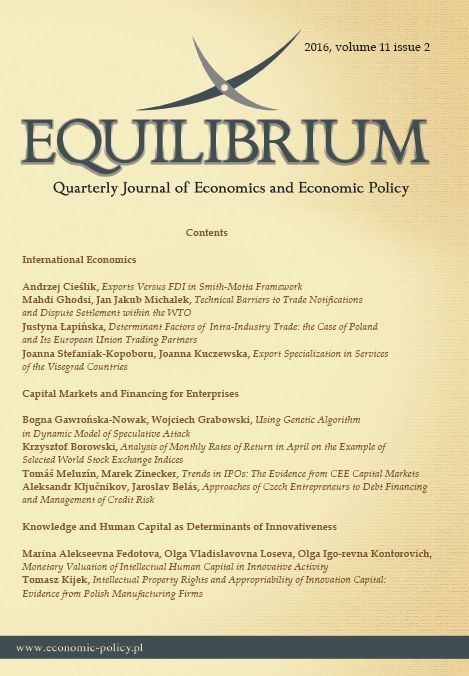Intellectual property rights and appropriability of innovation capital: evidence from Polish manufacturing firms
DOI:
https://doi.org/10.12775/EQUIL.2016.018Keywords:
innovation capital, appropriability mechanism, intellectual property rights, patent, knowledge production functionAbstract
This paper tries to find how firms use IPRs in the form of patents to protect innovation capital and find determinants of their effectiveness. The research is based on a large sample of 2960 Polish manufacturing firms that were engaged in developing and/or implementing a product or process innovation in the years 2010?2012. Besides descriptive statistics which show firms? attitudes toward the effectiveness of patents and their determinants, I apply the knowledge production function to find a link between patent propensity, R&D and innovation performance. Descriptive analyses show that Polish manufacturing firms rarely use patents as the appropriability mechanism, which results in the low level of their perceived effectiveness. It also turns out that the perceived effectiveness of a patent depends on a firm?s size, the innovation type and technological opportunities. In turn, the results of the knowledge production function estimation allow me to conclude that an increase in patent propensity affects the firm?s innovation performance positively.
Downloads
References
Arundel, A., & Kabla, I. (1998). What Percentage of Innovations are Patented? Empirical Estimates for European Firms. Research Policy, 27(2). DOI: http://dx.doi.org/10.1016/S0048-7333(98)00033-X.
Basberg, B. (1982). Technological Change in the Norwegian Whaling Industry: A Case Study of the Use of Patent Statistics as a Technology Indicator. Research Policy, 11(3). DOI: http://dx.doi.org/10.1016/0048-7333(82)90017-8.
Blind, K., Edler, J., Frietsch, R., & Schmoch, U. (2006). Motives to Patent: Empirical Evidence from Germany. Research Policy, 35(5). DOI: http://dx.doi.org/ 10.1016/j.respol.2006.03.002.
Cohen, W., Nelson, R., & Walsh, J. (2000). Protecting Their Intellectual Assets: Appropriability Conditions and Why US Manufacturing Firms Patent (or Not). Retrived from http://citeseerx.ist.psu.edu/viewdoc/download?rep=rep1&type=pd f&doi=10.1.1.216.2585 (01.03.2015).
Chesbrough, H. (2003). Open innovation, The new imperative for creating and profiting from technology. Boston: Harvard Business School Press.
Duguet, E., & Kabla, I. (1998). Appropriation Strategy and the Motivations to Use the Patent System: An Econometric Analysis at the Firm Level in French Manufacturing. Retrived from http://www.insee.fr/fr/publications-et-services/docs_doc_trav ail/g9717.pdf (13.03.2015).
Edvinsson, L., & Malone, M. S. (1997). Intellectual Capital: The Proven Way to Establish Your Company's Real Value by Measuring Its Hidden Brainpower. London: Judy Piatkus Ltd.
Gonzalez-Alvarez, N., & Nieto-Antol?n, M. (2007). Appropriability of Innovation Results: An Empirical Study in Spanish Manufacturing Rirms. Technovation, 27(5). DOI: http://dx.doi.org/10.1016/j.technovation.2006.12.004.
Greene W. H. (2008). Econometric Analysis. New Jersey: Prentice Hall.
Griliches, Z., & Pakes, A. (1980). Patents and R&D at the Firm Level: A First Report. Economics Letters, 5(4).
Hall, B. H., Helmers, C., Rogers, M., & Sena, V. (2013). The Importance (or not) of Patents to UK Firms. Oxford Economic Papers, 65(3). DOI: http://dx.doi.org /10.1093/oep/gpt012.
Hall, B. H., & Ziedonis, R. H. (2001). The Patent Paradox Revisited: An Empirical Study of Patenting in the US Semiconductor Industry. Rand Journal of Economics, 32(1). DOI: http://dx.doi.org/10.2307/2696400.
Hanel, P. (2008). The Use of Intellectual Property Rights and Innovation by Manufacturing Firms in Canada. Economics of Innovation & New Technology, 17(3). DOI: http://dx.doi.org/10.1080/10438590701581481.
Harabi, N. (1995). Appropriability of Technical Innovations. An Empirical Analysis. Research Policy, 24(6). DOI: http://dx.doi.org/10.1016/0048-7333(94)00812-4.
He, J., & Wang, H. (2009). Firm Innovative Knowledge Assets and Economic Performance: The Asymmetric Roles of Incentive- and Monitoring-based Governance Mechanisms. Academy of Management Journal, 52(5). DOI: http://dx.doi.org/10.5465/AMJ.2009.44633414.
Hurmelinna, P., & Puumalainen, K. (2007). Nature and Dynamics of Appropriability: Strategies for Appropriating Returns on Innovation. R&D Management, 37(2). DOI: http://dx.doi.org/10.1111/j.1467-9310.2007.00460.x.
Kijek, T. (2012). Innovation capital and its measurement. Journal of Entrepreneurship. Management and Innovation, 8(4).
Laursen, K., & Salter, A. (2006), Open for Innovation: the Role of Openness in Explaining Innovation Performance Among UK Manufacturing Firms. Strategic Management Journal, 27(2). DOI: http://dx.doi.org /10.1002/smj.507.
Lev, B. (2001). Intangibles: Management, Measurement, and Reporting. Washington: Brookings Institution Press.
Levin, R. C., Klevorick, A. K., Nelson, R. R., Winter, S. G., Gilbert, R., & Griliches, Z. (1987). Appropriating the Returns from Industrial Research and Development. Brookings Papers on Economic Activity, 18(3).
Licht, G., & Zoz, K. (2000). Patents and R&D. An Econometric Investigation using Applications for German, European and US Patents by German Companies. In D. Encaoua, B. Hall, F. Laisney & J. Mairesse (Eds). The Economics and Econometrics of Innovation. Boston: Kluwer Academic Publishers.
López, A. (2009). Innovation and Appropriability: Empirical Evidence and Research Agenda. Retrieved from http://www.wipo.int/export/sites/www/ip-development /en/economics/pdf/wo_1012_e_ch_1.pdf (11.03.2015).
McElroy, M. (2002). Social innovation capital. Journal of Intellectual Capital, 3(1). DOI: http://dx.doi.org/10.1108/14691930210412827.
Megna, P., & Klock, M. (1993). The Impact of Intangible capital on Tobin?s q in the Semiconductor Industry. American Economic Review, 83(2).
Organisation for Economic Co-operation and Development (OECD) (2012). New Sources of Growth: Knowledge-Based Capital. Paris: Directorate for Science, Technology, and Industry. Retrieved from http://www.oecd.org/sti/inno /newsourcesofgrowthknowledge-basedcapital.htm (10.03.2015)
Schumpeter, J. A. (1942). Capitalism, Socialism, and Democracy. New York: Harper.
Sirilli, G., & Evangelista, R. (1998). Technological Innovation in Services and Manufacturing: Results from Italian Surveys. Research Policy, 27(9). DOI: http://dx.doi.org/10.1016/S0048-7333(98)00084-5.
Sullivan, P. H. (2000). Value-Driven Intellectual Capital: How to Convert Intangible Corporate Assets Into Market Value. New York: John Wiley & Sons.
Wagner, K., & Hauss, I. (2000). Evaluation and Measurement of R&D Knowledge in Engineering Sector. In M. Khosrowpour (Ed.). Proceedings of the 2000 Information Resources Management Association International Conference on Challenges of Information Technology Management in the 21st Century. Amsterdam: IOS Press.
Zaby, A. (2010). The Decision to Patent. Contributions to Economics. Heidelberg and New York: Springer.
Zakrzewska, A., & Kijek, T. (2016). Market Valuation of Innovation-Related Intangibles: The Case of Polish Biotechnology Firms. In T. Dudycz, ?G. Osbert-Pociecha & ?B. Brycz (Eds). The Essence and Measurement of Organizational Efficiency. Heidelberg?New York?Dordrecht?London: Springer International Publishing. DOI: http://dx.doi.org/10.1007/978-3-319-21139-8_20.






